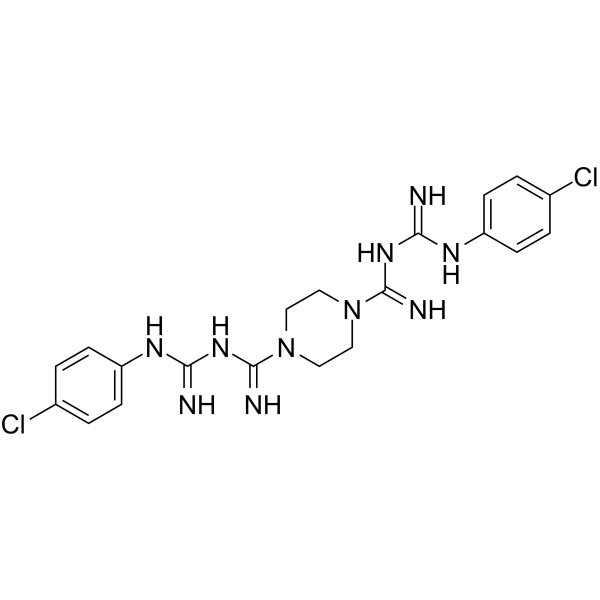
Picloxydine
CAS No. 5636-92-0
Picloxydine( —— )
Catalog No. M26376 CAS No. 5636-92-0
Picloxydine has antiplaque and antibacterial activity. Picloxydine has a destructive effect on the bacterial cell wall and plasma membrane, which leads to cell lysis and release of intracellular components.
Purity : >98% (HPLC)
 COA
COA
 Datasheet
Datasheet
 HNMR
HNMR
 HPLC
HPLC
 MSDS
MSDS
 Handing Instructions
Handing Instructions
| Size | Price / USD | Stock | Quantity |
| 5MG | 484 | Get Quote |


|
| 10MG | 700 | Get Quote |


|
| 25MG | 1062 | Get Quote |


|
| 50MG | 1431 | Get Quote |


|
| 100MG | 1962 | Get Quote |


|
| 500MG | 3924 | Get Quote |


|
| 1G | Get Quote | Get Quote |


|
Biological Information
-
Product NamePicloxydine
-
NoteResearch use only, not for human use.
-
Brief DescriptionPicloxydine has antiplaque and antibacterial activity. Picloxydine has a destructive effect on the bacterial cell wall and plasma membrane, which leads to cell lysis and release of intracellular components.
-
DescriptionPicloxydine has antiplaque and antibacterial activity. Picloxydine has a destructive effect on the bacterial cell wall and plasma membrane, which leads to cell lysis and release of intracellular components.(In Vivo):While picloxydine in higher concentration suppressed the oral flora more effectively than chlorhexidine, the latter agent inhibited plaque development to a much greater extent.?This lack of correlation between antibacterial and antiplaque activity can be related to structural differences between these two bis-biguanides.
-
In Vitro——
-
In Vivo0.4% Picloxydine produces a highly significant drop in the number of aerobic organisms. 0.4% Picloxydine is far more effective than 0.2% Picloxydine or chlorhexidine in reducing the total viable count of oral aerobic and anaerobic organisms. Picloxydine is also used in eye drops in the topical therapy of trachoma.
-
Synonyms——
-
PathwayGPCR/G Protein
-
TargetAntibacterial
-
RecptorCaspase-3| Caspase-9| ERK| MEK1
-
Research Area——
-
Indication——
Chemical Information
-
CAS Number5636-92-0
-
Formula Weight475.38
-
Molecular FormulaC20H24Cl2N10
-
Purity>98% (HPLC)
-
SolubilityIn Vitro:?DMSO : 11.36 mg/mL (23.90 mM)
-
SMILESClc1ccc(NC(=N)NC(=N)N2CCN(CC2)C(=N)NC(=N)Nc2ccc(Cl)cc2)cc1
-
Chemical Name——
Shipping & Storage Information
-
Storage(-20℃)
-
ShippingWith Ice Pack
-
Stability≥ 2 years
Reference
1.Lelli D, Pedone C, Sahebkar A. Curcumin and treatment of melanoma: The potential role of microRNAs. Biomed Pharmacother. 2017 Apr;88:832-834.
molnova catalog



related products
-
Mitonafide
Mitonafide suppresses the activity of M. tuberculosis NAD+ dependent DNA ligase A. Mitonafide is a DNA intercalating agent.
-
IDI-6273
A potent, mutant-selective PfDHODH inhibitor with IC50 of 210 nM for 3D7 E182D PfDHODH.
-
BEC HCl
BEC HCl is a competitive arginase inhibitor, which bind slowly. Ki of BEC HCl is 0.31 μM (pH7.5) for Arginase II, and is 0.4-0.6 μM for rat Arginase I.



 Cart
Cart
 sales@molnova.com
sales@molnova.com


